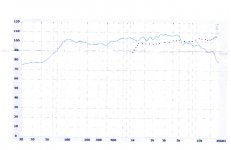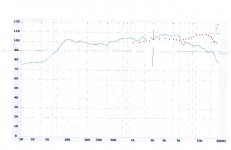As a "thought experiment", some musings, trying to design a super high efficient two-way. The two culprits are the Audio Nirvana 15" classic ferrite, and the Aurum Cantus G3...
By plotting the two together, my best guess is a first order for the AN 15 at about 2K, so by 4K it has tamed that rising response, dragging down that hot spot 6Dbs worth...what do you guys think?
----------------------------------------------------------------------Rick........
By plotting the two together, my best guess is a first order for the AN 15 at about 2K, so by 4K it has tamed that rising response, dragging down that hot spot 6Dbs worth...what do you guys think?
----------------------------------------------------------------------Rick........
Attachments
Last edited:
Hey Richard, I'd think the dip at around 1100Hz would be a good place to hook in. This would be the first breakup mode and narrowing happens here too. By crossing higher, since the tweeter requires it, this changes and it becomes uncertain whether a flat response is better or not.
@1100hz that G3 looks to have a steep cutoff. Not getting a 1st order xo response out of him @1100hz. Richard, are you married to these two components? If so, I think you're looking at a steeper xo. That's not the end of the world. IME, with the heils pleated diaphragm, trying to eq a lower end response UP isn't optimal. You can do some but beyond a few db it'll start sounding unpleasant. You might be able to do a LR2 around AllenB's suggestion. That will sound pretty good. You'll be looking at some baffle step around 4-500hz anyway and I'd think that would work out easier with a bit lower xo than 2khz.
Then I got to ask if another less expensive woofer wouldn't be a better option?
Then I got to ask if another less expensive woofer wouldn't be a better option?
Last edited:
Since you mention it I may as well clarify what I was thinking. From the start I didn't expect those two to go together, with the ribbon getting wider as well.
However the 15" is a 'full range', but this doesn't change the directivity mismatch. On the other hand, with a treated room, and one listener you never know.
However the 15" is a 'full range', but this doesn't change the directivity mismatch. On the other hand, with a treated room, and one listener you never know.
A crossover is best designed with experience and hearing the speaker.
All computer aided design lack the fact that they aren't able to hear the speaker.
No CAD will ever be able to optimise a speaker in the way real auditioning can do.
All computer aided design lack the fact that they aren't able to hear the speaker.
No CAD will ever be able to optimise a speaker in the way real auditioning can do.
A crossover is best designed with accurate measurements and calculation. Listening is used for the fine-tuning.
Musical source material is never able to reveal every weakness of a design because even a large collection of one's favourite test tunes does not contain the whole audio frequency range.
Musical source material is never able to reveal every weakness of a design because even a large collection of one's favourite test tunes does not contain the whole audio frequency range.
Musical source material is never able to reveal every weakness of a design because even a large collection of one's favourite test tunes does not contain the whole audio frequency range.
What if I like listening to pink noise? 😉
Looks to me like there are three approaches here:
One would be to, as Richard mentioned, use a first-order electrical filter at 2kHz on the woofer, which would result in a rolloff at 4kHz and bring the ribbon in there. Seems pretty sensible.
Another would be to use the ribbon where the HF response of the 15" falls off - somewhere above 5kHz.
IMO, ribbons shouldn't be made to run anywhere near their lower cutoff. While the 1.1kHz crossover point looks okay from a frequency response point of view, I'd want to do a LOT of testing before settling on that design.
As others have noted, the off-axis response is likely to get weird in any case.
Chris
A crossover is best designed with accurate measurements and calculation. Listening is used for the fine-tuning.
Musical source material is never able to reveal every weakness of a design because even a large collection of one's favourite test tunes does not contain the whole audio frequency range.
A crossover should be designed with calculation and experience.
Not everything which is listenable is measureable.
Even in other fields (like optics) the last judgement is done by ear (or eye).
How will you judge the Bokeh of a lens by measurements? It's impossible. But not many think this way, most of the audio designers believe in measurements. Listening is unnecessary.
A crossover is best designed with experience and hearing the speaker.
All computer aided design lack the fact that they aren't able to hear the speaker.
No CAD will ever be able to optimise a speaker in the way real auditioning can do.
True, Plus anyone who's tried to measure a speaker at higher crossover points know that moving the mic inches changes the measurements. That said, a designer should still measure but also use a combination of theory, measurement and listening at a proper position to dial in the sound.
If you have two amps, you can play/learn/listen to a digital XO using minidsp. When you are satisfied, eventually build a passive version later, just a tought🙂
A crossover is best designed with experience and hearing the speaker.
All computer aided design lack the fact that they aren't able to hear the speaker.
No CAD will ever be able to optimise a speaker in the way real auditioning can do.
"Human perception systems are rife with always getting it wrong...that's why we have science...machines...they'll always get the data right".
If indeed you "beiieve" you hear something that cannot be measured, documented, quantified...then either your ears are giving you false data, or there still exists a particular component within sound that our devices can not yet detect...I would suspect the former.
--------------------------------------------------------------------Rick.........
I have not read the whole thread, but I recently worked on betsy and ribbon tweeter. I got the same question, where to select crossover. My approach is to make the decision based on the beaming characteristics of the full range. Otherwise you will end up with uneven off axis response.
So I would measure not just the fr response on axis, but at 10, 20, 30 and 40 degrees, and place the crossover point just below it starts severely beaming.
betsy wow and ribbon
So I would measure not just the fr response on axis, but at 10, 20, 30 and 40 degrees, and place the crossover point just below it starts severely beaming.
betsy wow and ribbon
I'm acutely aware of beaming from a large full-ranger as my current mains are a pair of sixties era Leea 1222xes'...a twelve inch FR in a modified original enclosure. The beaming effect is so profound, somewhere along the line, the previous owner(s) added the "horn" section from an old Pioneer PAX-200 6 1/2 inch two-way...they wound up just mounting it inside the rather large front facing port...??
------------------------------------------------------------------------Rick.............
------------------------------------------------------------------------Rick.............
By plotting the two together, my best guess is a first order for the AN 15 at about 2K, so by 4K it has tamed that rising response, dragging down that hot spot 6Dbs worth...what do you guys think?
I think that first we need to understand what those SPL curves show, and how they were measured. Baffle? The woofer was curve was most likely measured in-room (NOT anechoic) since it extends to well below 300 Hz. This is not useful to design a loudspeaker.
To design a real-world speaker with balanced sound, you'll need anechoic measurements and you'll have to consider the baffle step and the dispersion of the drivers. Only once you add these information you should think about the x-over.
Assuming you want to work 0dB to the level set between 700-1k4Hz, it's +3dB at 2k7. If you cross there you'll leave a small dip behind it at lower frequencies. Toward twice this frequency it is +4dB without the filter and 0 to -1dB with.first order for the AN 15 at about 2K, so by 4K it has tamed that rising response, dragging down that hot spot 6Dbs worth...what do you guys think?
The bump you are trying to work with is sharper than first order.
A crossover is best designed with experience and hearing the speaker.
All computer aided design lack the fact that they aren't able to hear the speaker.
This is just plain backwards.
Designing a good xover starts with getting good measurement data, and you need some sort of modeling of the xover (most people use a computer these days). A good approach is to measure the anechoic SPL curves of the raw drivers in the baffle / box, at different angles. Then you start modeling the xover using some CAD tool, and run the measurements through this model. You change the xover model until things look good. If you know how to interpret the data, you'll end up with a decent xover design. Of course tweaking will be necessary by listening with your ears, but this is also much more efficient if you can reproduce the tweaks by measurements.
Ok, please don't hate me here guys...but I made a boo boo...I kept thinking just why this didn't work...& I couldn't place it...it was the wrong tweeter driver plot , it was Aurum Cantus alright, but it was the G1, not the G3...
The G1 plot was the one I originally had in mind...& I couldn't put my finger as to why things weren't working out...
Here is the correct plot, note the rising response as it clears 6K....it just starts climbing towards 110 Db...maybe a first order starting at 7K?
---------------------------------------------------------------Rick........
The G1 plot was the one I originally had in mind...& I couldn't put my finger as to why things weren't working out...
Here is the correct plot, note the rising response as it clears 6K....it just starts climbing towards 110 Db...maybe a first order starting at 7K?
---------------------------------------------------------------Rick........
Attachments
OK, 2K is the crossover point, done...but the big ribbon tweeter starting at 5000 hertz and 102 Db or so...by 10,000 hertz it is screaming along at 109 Db...a seven Db increase in one octaves worth.
That whole climbing rate needs to be attenuated ...slowly nulling out that rising response.
We have two rising humps of response, the big Audio Nirvana 15 is crossed over before its own climbing response, the tweeter has its own bump of response...the idea is to level off & smooth over things, so we don't have a "screaming" range of frequencies.
-------------------------------------------------------------------------Rick......
That whole climbing rate needs to be attenuated ...slowly nulling out that rising response.
We have two rising humps of response, the big Audio Nirvana 15 is crossed over before its own climbing response, the tweeter has its own bump of response...the idea is to level off & smooth over things, so we don't have a "screaming" range of frequencies.
-------------------------------------------------------------------------Rick......
- Home
- Loudspeakers
- Multi-Way
- High efficiency Two-way design, where to cross them

